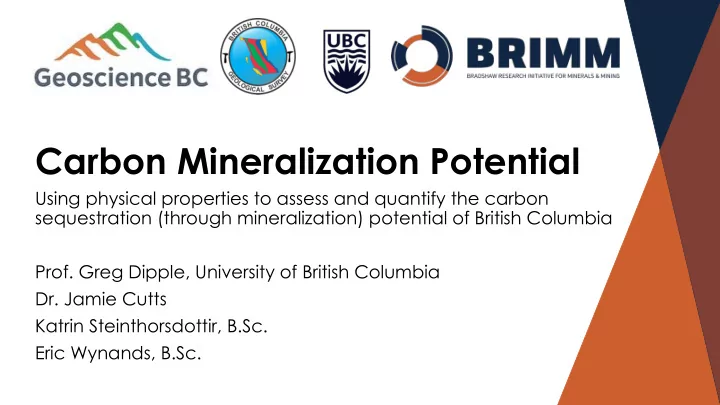

Carbon Mineralization Potential Using physical properties to assess and quantify the carbon sequestration (through mineralization) potential of British Columbia Prof. Greg Dipple, University of British Columbia Dr. Jamie Cutts Katrin Steinthorsdottir, B.Sc. Eric Wynands, B.Sc.
Carbon Mineralization Carbon mineralization offers advantages over gas/liquid storage: - stable over millennia - dense - virtually unlimited capacity (Petatonnes) - geologic setting differs from “conventional” CCS But slow to form in nature. Lackner, Science, 2003 Kelemen after Coleman (1977)
Emissions Projections and Climate (Modified after Fuss et al., 2014, Nature )
Active Carbon Mineralization at Mine Sites
400 t/year CO 2 11 Mt tailings 0.4 kg CO 2 / m 2 / year 3 kg CO 2 / m 2 / year Diavik Diamond Mine, North West Territories, Canada Lab-based “soil” gas flux measurements 460 t/year CO 2 40,000 t/year CO 2 0.9 kg CO 2 / m 2 / year 2.4 kg CO 2 / m 2 / year Woodsreef Chrysotile Mine, NSW, Australia Mt Keith Nickel Mine, WA, Australia
Carbon Mineralization Rates (Modified after Harrison et al., 2013, ES&T )
Embracing Geological Diversity Focus interventions on the most reactive tailings Baptiste Deposit, B.C. MTonnes Ore Labile Mg (Wt. % MgO) (Vanderzee et al., 2019)
Ultramafic rocks in BC Ophiolites Fragments of the ocean floor, including the underlying upper mantle Intrusions Crystallized magmatic systems
Goals Use geologic maps, chemistry, and remote sensing to quantify carbon sequestration capacity of ultramafic rocks 1. Constrain physical property responses to alteration • Magnetic Susceptibility • Density • Conductivity/resistivity 2. Establish 3D models of ultramafic rocks for mineralization using geophysical inversions 3. Establish carbon sequestration (through mineralization) potential index for BC
A B.C. Perspective: (L)NG Transport
Recommend
More recommend